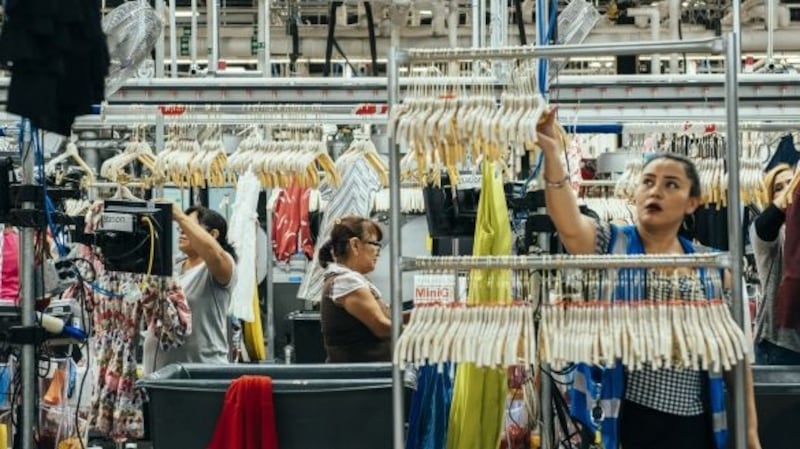“We came for a visit and we just fell in love with the city. It felt like home.” Anushka Salinas, chief operating officer of Rent the Runway, is explaining exactly what attracted the fashion platform to Galway.
The subscription service, which was founded in 2009 by Jennifer Hyman and Jennifer Fleiss, set up in the city in 2019, with plans to employ 150 people. After starting out in Portershed, Galway’s innovation hub, Rent the Runway now has an office in the Claddagh area of the city. It is tasked with tackling some of the core technology challenges that are vital to Rent the Runway’s success and development as a platform.
The Galway office was the first location outside the US for the company, and so far it has proved to be a good investment.
“Our initial focus in looking to expand outside of the US was all about software engineering. Like so many companies, especially in 2018 and 2019, we were really having a hard time finding great talent in New York; there was so much competition for the right talent,” says Salinas. “We came here really because of the incredible engineering talent [in Galway], based on the universities that are nearby. And that has proven to be absolutely true, based on the incredible talent that we’ve seen here.”
READ MORE
On the face of it, the business might be about fashion, but at the heart of it is data: on its clothing, on what its customers want – and more importantly what they don’t
That engineering talent is vital to the platform’s success. Rent the Runway offers a “closet in the cloud”, providing access to hundreds of outfits to subscribers, from designer wear and occasion outfits to regular day-to-day clothing.
As a totally digital business – Rent the Runway no longer has real-world shops open to customers where they can go and browse and the outfit selection – having the whole experience go smoothly and be positive for consumers is critical to its success. From showcasing outfits and making suggestions to customers to ensuring the delivery process is optimised as much as possible and stock is managed correctly, a misstep could lead to subscribers cancelling – and with the cost-of-living crisis already seeing customers be more discerning about what they spend their money on, Rent the Runways is keen to avoid becoming a casualty.

On the face of it, the business might be about fashion, but at the heart of it is data: on its clothing, on what its customers want – and more importantly what they don’t.
That allows the company to predict the potential success of outfits, tap into trends and choose items of clothing that it knows will appeal to its customer base. But it’s not just valuable to the company; the data has also been useful to designers and clothing companies, with feedback on fit helping to shape how designers are making clothes. That may change in the coming years, with plans to eventually expand its services globally. Ireland is one of the potential targets for the company’s expanded services – whenever that may come.
“We’re able to use some of that data to predict, based on the characteristics and the attributes of an item, whether it will be successful for us. That data is incredibly helpful for our buying team and we share that with designers,” says Salinas. “Maybe a specific type of dress silhouette does not work for us, and we would shy away from buying something like that, and we would lean into things that we’ve seen have been successful in the past. Of course, sometimes there’s new trends and you just have to know whether that trend is going to be appropriate for your customer.”
[ Looking for a new frock? Here’s why you should rent, not buyOpens in new window ]
Some of the company’s most innovative features have been created at least in part by the team in Galway, including the website’s fit tool, which helps customers choose the correct size for different brands. The product catalogue, which functions as an inventory of its stock, plus the reverse logistics, were built from the ground up in Galway, too. It’s a key piece of the company’s strategy, says Salinas. With teams split between the US and Ireland, you might think that managing collaboration is difficult. But Rent the Runway was already implementing a hybrid model of working when the pandemic hit, so it was ready to hit the ground running.
In fact, having teams working together but located in different time zones has proven to be more of a benefit than a hindrance, allowing the company to have around-the-clock coverage for its customers.
“It’s an interesting dynamic; the folks here in Galway get a head start on the day and they’re able to be ‘heads down’ and really focus without being disrupted by New York; then New York comes online midday and they have a good amount of overlap where we’ll do our all-hands company meetings, and team check-ins. Then New York has their heads-down time after the Galway team goes home for the day. So we actually we leverage the time difference strategically.”
The company hasn’t escaped the current tech downturn, with the company last year announcing a 24 per cent cut in the number of corporate employees
Executives regularly check in, too. The chief technology officer comes to Galway about once every quarter, and Salinas visits every six months, which is about as often as she can. Those who manage teams or are part of leadership make frequent trips to Galway, too, “just to make sure that we get the face-to-face time to build the relationships in addition to just the collaboration over Zoom”.
It hasn’t all been positive. When Rent the Runway floated on the stock market in 2021, it was at a $21 a share; that has since lost more than 80 per cent of its value to trade at less than $3. The company’s valuation has been hit as a result.
It also hasn’t escaped the current tech downturn, with the company last year announcing a 24 per cent cut in the number of corporate employees. But it is still recruiting for key roles, and has expanded the scope of the roles it is hiring for in Galway. Initially, software engineering, the focus has also turned to product and data, user experience and mobile engineering, and Rent The Runway now has an internal audit function in Galway.
“When new critical roles pop up, Galway is top of mind – does this role need to be in New York, or is this a role that we can kind of think about putting in Galway?” says Salinas. “I’d say we are being opportunistic, especially as we’re finding that there is great talent on the market here and we are thinking about expansion of functions.”
[ Tech layoffs end decade-long boom and put Ireland on edgeOpens in new window ]
However, despite the close ties to Ireland, there are no plans to launch the service here, or indeed anywhere outside the US.
“I think we’re very focused right now on our path to profitability,” says Salinas. “But so until we reach profitability, I think large investments are not on the horizon. It’s something that we would look to after we meet that milestone and think about what those next big growth opportunities are for us.”
International expansion is a potential opportunity in the future, and the company is evaluating its options.
Another opportunity lies in pitching itself as a sustainable alternative to fast fashion, an increasing consideration as people become more aware of the environmental impact of the fashion industry. Take a look at your wardrobe; unless you operate a disciplined culling process on a regular basis, there’s a good chance that roughly half the clothes there are rarely worn, if ever. The closet-in-the-cloud approach removes that waste. Clothes are new to customers, and satisfy the need to change up a wardrobe without contributing to fashion landfill.
The sustainability thread extends through the life cycle of Rent the Runway’s clothes, which sends nothing to landfill, even after the clothing has come to the of its life
And while there is an inevitable impact from the cleaning and transport of garments, the overall environmental impact is lower than creating new items.
“The core of what our product offering is driving higher utilisation of garments, which leads to better sustainable and more sustainable outcomes in fashion,” says Salinas.
That sustainability thread extends through the life cycle of Rent the Runway’s clothes, which sends nothing to landfill, even after the clothing has come to the of its life.
“We have a 100 per cent diversion rate from landfill so none of the Rent the Runway garments that we dispose of end up in landfill,” says Salinas. “We have a couple of different channels. We sell products to our customers. It’s really a benefit to our subscribers. If they have something at home and they love it, they can just pay an additional fee to keep it forever.”
“We’ve set ambitious goals for ourselves: to displace the need for production of 500,000 garments by 2026.”




















